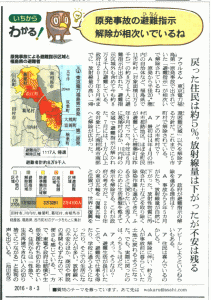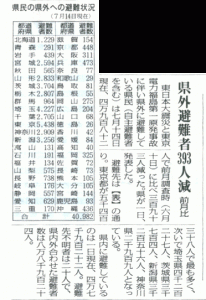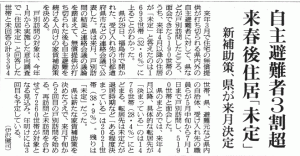Original Japanese written by staffer
The English below written and arranged by Heeday, based on the original Japanese
The English edited by Rev. Dr. Henry French, ELCA
Based on articles from the July 30th and August 3rd, 2016 editions of the Asahi Shimbun newspaper and the August 2nd, 2016 edition of Fukushima Minpo newspaper
Evacuation orders lifted, but evacuees….
An evacuation order was issued in many districts soon after the meltdown began at TEPCO’s Fukushima Daiichi Nuclear Power Plant, and now the order has been lifted for one district after another. Japan’s national government plans to lift all such orders by the end of March 2017, except for the “no return zones” where the radiation levels are still high. One intention of the government is to call the 2020 Tokyo Olympics the “Olympics of Recovery” and let the world know how well Japan has recovered from the March 2011 disaster.
So far, thanks to the evacuation orders that have been lifted, some 20,000 citizens are now “eligible” to return to their hometowns. How many of them, however, have actually “gone home?” In fact, only 5% or so. After spending some years as evacuees, many have gotten a job in the places they evacuated to, many are going to school there, and now, for many of them, the places they evacuated to have become a home where they make their living.
We can safely conclude that five years is too long a period to be called “evacuation.” Another factor preventing many from returning is that radiation is still an issue in many of their hometowns. Also, many of their hometowns today have only a few stores, clinics, etc. Thus, many evacuees, especially younger ones, find it hard to return.
Where to go?
At the same time, TEPCO and the national government are terminating their compensation and livelihood support payments to the evacuees. Many of the evacuees, called “voluntary evacuees,” left their homes without an order from the government. For evacuees of this kind, in compliance with the Disaster Relief Act, Fukushima’s prefectural government and the relevant municipal governments have rented some apartment rooms, both in and out of Fukushima Prefecture, and offered them to these evacuees free of charge. The prefectural government has decided to terminate this program at the end of March 2017. Every evacuee affected by this decision is now forced to make a tough decision – to continue to live as a “voluntary” evacuee on their own expense, or to return to their hometown.
 Affected by the March 2011 earthquake and the Fukushima Daiichi meltdown, 40,982 Fukushima citizens are currently in evacuation (including voluntary evacuees), as of July 14th, 2016. Also, as of August 1st, 2016, 47,922 others are still living inside the prefecture, but not in their hometowns. Twenty other people are living in evacuation in unidentified places. Thus, a total of 88,924 are in evacuation in and out of the prefecture.
Affected by the March 2011 earthquake and the Fukushima Daiichi meltdown, 40,982 Fukushima citizens are currently in evacuation (including voluntary evacuees), as of July 14th, 2016. Also, as of August 1st, 2016, 47,922 others are still living inside the prefecture, but not in their hometowns. Twenty other people are living in evacuation in unidentified places. Thus, a total of 88,924 are in evacuation in and out of the prefecture.
Finding a place is quite difficult
Fukushima’s prefectural government officials and some other individuals visited some voluntary evacuees in and out of Fukushima in their residences. They successfully interviewed some 5,190 households. 1,693 (32.6%) of them had yet to figure out where to live after April 2017.
Many of the voluntary evacuees are households consisting of a mother and her child/children who fled from their original homes as soon as possible to protect themselves from radiation, taking only what they could carry with them. To such households, the termination of the rent-free apartment program is a critical issue. Moreover, in addition to their difficult life as evacuees, countless voluntary evacuees experience discrimination and prejudice from some of people around them.
Living with radiation
Parents raising a child in Fukushima still experience numerous conflicts and anxieties. As time goes by, those living in the prefecture talk less and less about radiation. Once you have chosen to stay there, you simply have to live with radiation, which does not disappear. Still, in many places, the radiation levels are still dangerously high, although many residents just avoid talking about it. Some residents just ignore radiation, while others take all the protective measures they can. Each resident here has their own standard of radiation protection for their own life.
The Japanese author’s wish
Some media reports claim that residents of Fukushima have no more need to worry about radiation, while others say that radiation is still dangerously high. Both opinions are widespread. I hope that voluntary evacuees outside Fukushima will learn as much as they can about the radiation in the prefecture. If possible, they should visit their hometowns and just walk around. This way, I hope, they can clearly learn both the advantages and disadvantages of returning home and thereby make the best decision for themselves.
I also call for the Japanese government and the relevant municipal governments to provide as much help as they can to voluntary evacuees as they face new and uncertain lives.
